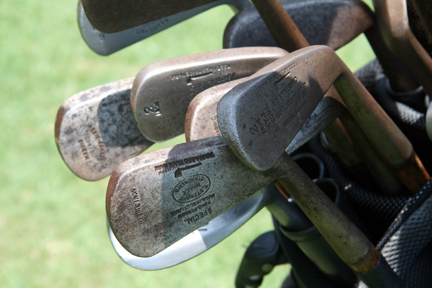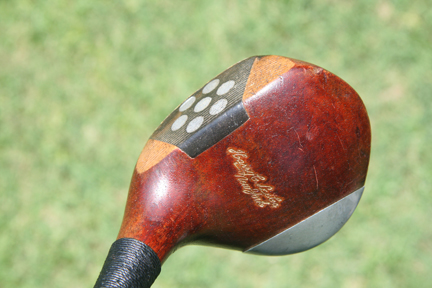post
Bobby Jones-era Hickory Golf Clubs

You never know what will come through the Sanctuary doors. Last week, John Rosemond, a speaker for a group staying in The Sanctuary, brought with him an authentic set of Bobby Jones-era hickory-shafted golf clubs.
Rosemond has spent a good part of the last six years researching classic hickory clubs and putting together a complete set.
Back in the 1930s, while American clubs were mass-manufactured, in the U.K., they were still handmade by skilled craftsmen. Rosemond’s research found that the clubs Bobby Jones used were made at St. Andrews by the premier club maker of the era, Tom Stewart. Searching on eBay and club dealers from around the world, he was able to put together a complete set of irons.
“The interesting thing is that right around 1930, club makers started numbering their clubs rather than using names like ‘mashie’ or ‘niblick,” explained Rosemond. “So my set has some numbered and some with names. Also, the faces of the clubs varied greatly. Some had dimpled faces, dotted line grooves, full-length grooves; some were even smooth. I searched for clubs with grooved faces.”

While Stewart was the best iron maker of the era, George Nicoll, who was a club maker from the Fife town of Leven, made the best putters. The best woods of the era were American made by Harry Lee from Upstate New York. So, Rosemond carries a Nicoll putter and a driver, brassie and a spoon made by Lee.
The cost of the set was actually comparable to current technology. He paid between $100 and $300 for each iron and about $250 for each wood, so the entire set cost him a little over $2,000.
For those interested in playing hickories, he has some tips for playing them. “You better have a very fluid swing,” said Rosemond. “People who swing too hard will find that the shaft won’t catch up to their hands. My father, who was a golf professional here in Charleston, taught me to pause at the top of the swing to allow the clubs to ‘set’ (i.e. allow the shaft to catch up to the hand motion) and then hit down upon the ball.” Rosemond explained that the current technology encourages players to sweep the ball while the “blades” of the Bobby Jones-era forced players to take a more abrupt angle into the ball.

Another important point that Rosemond made is that “while today’s clubs have bigger sweet spots, it’s less concentrated. When you hit the sweet spot on these clubs, I can get 300-yard drives. The clubs are less forgiving but much more accurate.”
Rosemond uses a modern ball – Bridgestone E-6 – as it’s the softest “distance” ball.
While at Kiawah, Rosemond played The Ocean Course. “It beat me to death,” he said. Not so much due to the clubs, but due to the heat and walking. “In my prime, I was a solid 3 handicap. Now, I’m 65 and was playing with a bunch of folks 45ish so was dragging by the 15th hole. If I played Osprey Point, or another of the resort’s courses, I would have improved my score significantly.”
For those interested in hickory clubs, Rosemond suggested contacting Randy Jensen of www.hickorygolf.com. “He’s a 4 or 5 time U.S. Hickory Open champion and is a whiz at reconditioning hickory clubs – he can refinish the heads, put new hickory shafts on and regrip with traditional buffalo hide grip – suede-side out.”